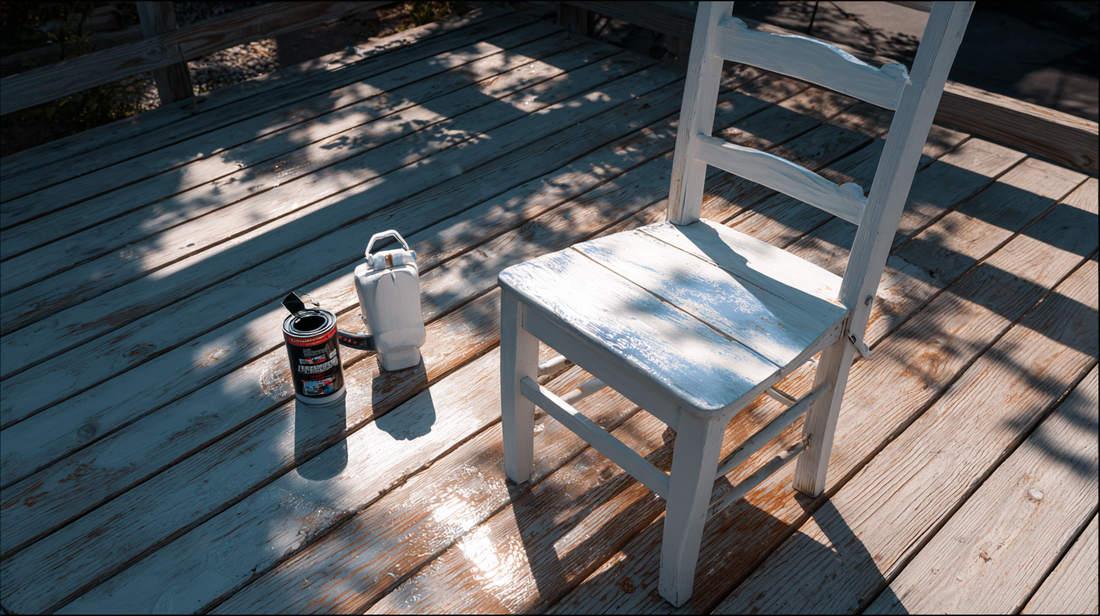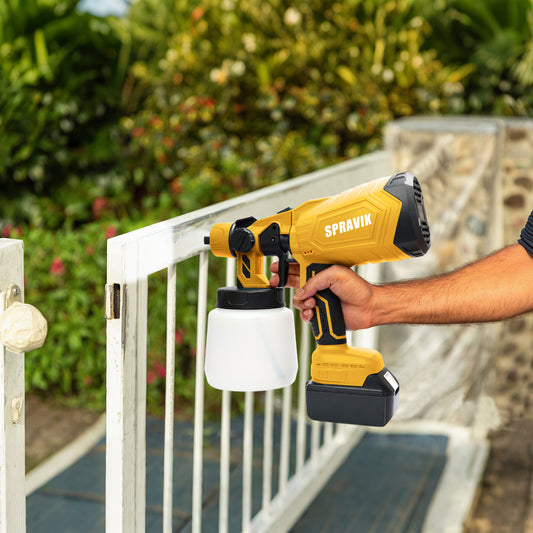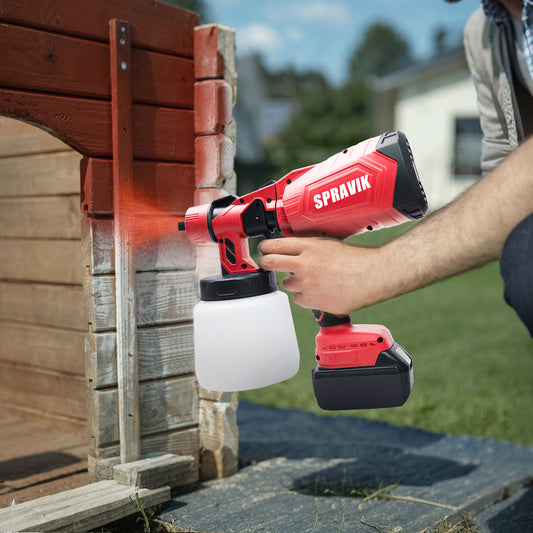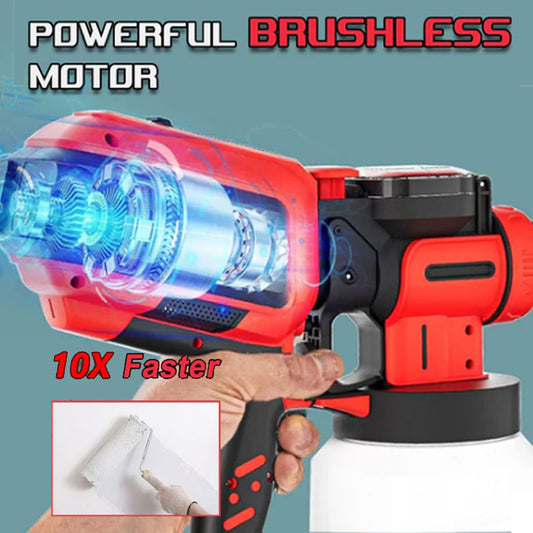
How Long Does Spray Paint Take to Dry? A Detailed Guide for DIYers
Spravik AdminSpray painting is one of the most efficient and versatile methods for applying a smooth, even coat of paint on almost any surface. Whether you’re refreshing old furniture, upgrading your home decor, or tackling a garage project, knowing how long spray paint takes to dry is essential. For DIYers aiming for professional results, timing is everything.
In this comprehensive guide, we’ll explore all the key factors affecting spray paint drying time, how tools like an airless paint sprayer or a painter airless paint sprayer impact results, and why choosing products like black spray paint requires specific attention.
The Basics of Spray Paint Drying Time Drying time refers to how long it takes for paint to reach a point where it is no longer tacky to the touch. There are generally four stages of spray paint drying:
Surface dry: The top layer feels dry.
Touch dry: You can touch it lightly without leaving fingerprints.
Hard dry: The paint is no longer soft and won’t dent.
Fully cured: The paint reaches its maximum hardness and durability.
Average Drying Times by Paint Type:
Enamel spray paint: 10-30 minutes to touch, 24 hours to cure.
Lacquer spray paint: 3-5 minutes to touch, 3 hours to hard dry.
Acrylic spray paint: 10-20 minutes to touch, 8 hours to hard dry.
Oil-based spray paint: 30-40 minutes to touch, 8-24 hours to cure.
However, these numbers are just estimates. Several factors can alter the actual drying time significantly.
Key Factors That Affect Drying Time
1.Temperature: Ideal spray painting occurs between 65–85°F (18–29°C). Cold slows drying, while excessive heat may cause bubbles.
2.Humidity: High humidity levels extend drying time since moisture in the air prevents solvents from evaporating quickly.
3.Air circulation: A well-ventilated area helps speed up drying by promoting solvent evaporation.
4.Surface material: Porous surfaces like wood absorb paint faster, while metal and plastic require more drying time.
5.Number of coats: Thicker applications take longer. Applying multiple thin layers speeds up the process.
6.Paint type and brand: Quality and formulation matter. Some fast-drying brands cure more quickly than others.
The Role of Equipment: Why Tools Matter Using the right painting equipment makes a big difference in drying results. An airless paint sprayer atomizes paint through high pressure, delivering an ultra-fine mist that adheres evenly and dries faster due to thin, consistent layers.
A painter airless paint sprayer designed specifically for detailed DIY and professional work helps minimize overspray and reduces the need for reapplication. The thinner coats laid by these tools tend to dry more uniformly than traditional spray cans or rollers.
Pro Tip: DIYers using an airless paint sprayer should practice consistent motion and maintain the right distance (usually 10–12 inches from the surface) to avoid drips and uneven texture.

Special Consideration: Black Spray Paint Black spray paint is popular for its depth and dramatic finish. However, black pigment tends to highlight surface imperfections and uneven coverage.
Drying Time Tips:
Apply thin coats: Black can look blotchy if applied too thick.
Watch for sheen variation: Glossy black may require longer cure time than matte finishes.
Use primer: A neutral primer helps with better adhesion and faster drying.
Recommended Products:
Rust-Oleum Universal All Surface Black Spray Paint (fast-drying)
Krylon Fusion All-In-One Satin Black
Indoor vs Outdoor Spray Painting Outdoor conditions vary greatly and can significantly affect drying. Indoors offers more control but requires excellent ventilation.
Outdoor Tips:
Avoid painting when humidity exceeds 85%
Check wind speed to prevent dust contamination
Use sun exposure to accelerate drying but avoid direct heat
Indoor Tips:
Use fans or cross-ventilation to aid airflow
Consider a dehumidifier if working in a basement or garage
Lay down drop cloths and protect surroundings
Drying Time by Surface Type
Wood: Absorbs paint, dries faster, but may require sanding between coats.
Metal: Slower to dry; must be rust-free and primed.
Plastic: Needs a specialized primer to prevent peeling and slow drying.
Glass: Use light coats; allow extended curing to prevent streaks.
Speeding Up the Drying Process
Use a heat gun (carefully and at a distance)
Increase room temperature (70–75°F is ideal)
Use quick-dry formulas
Use an airless paint sprayer for thinner application layers
Common Mistakes That Slow Drying
Painting in high humidity or cold
Applying thick, uneven coats
Not allowing sufficient time between layers
Failing to shake the can or stir paint properly
How Long Should You Wait Between Coats? This depends on the product, but general recommendations are:
Light coats: Wait 5–15 minutes
Heavy coats: Wait 30–60 minutes
Airless sprayer coats: 10–20 minutes due to faster solvent evaporation
Check manufacturer’s label for exact timing. Waiting too little between coats causes wrinkling or poor adhesion.
Fully Cured vs Touch Dry: Why It Matters Don’t confuse “touch dry” with full readiness. For example, a painted metal chair may feel dry in 30 minutes but still be vulnerable to scratches for 24–48 hours. Full curing ensures resistance to chemicals, moisture, and physical damage.
How to Test if Spray Paint is Fully Dry
Press with a gloved hand: If no print remains, it’s hard dry.
Fingernail test: Press gently in a hidden spot. If it doesn’t dent, it’s cured.
Odor: Fully cured paint should have minimal or no smell.
Best Practices for DIYers Using an Airless Paint Sprayer
Always clean the sprayer after use to prevent clogging
Test spray on cardboard before applying to actual surface
Use tip guards for better control and safety
Keep the spray gun perpendicular to the surface
Conclusion: Spray Smart, Dry Right Spray paint drying time varies, but with the right tools—especially an airless paint sprayer or painter airless paint sprayer—and proper environmental control, you can drastically improve efficiency and finish quality. Special considerations for materials, paint types (like black spray paint), and techniques ensure that your DIY project turns out clean, crisp, and long-lasting.
Patience during the drying process is the hidden key to success. Fast isn't always better—but smart, well-timed application is.
So next time you pick up your paint sprayer, remember: prep well, spray right, and give it the time it truly needs to dry and cure. Your projects—and your future self—will thank you.










